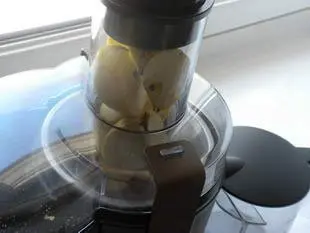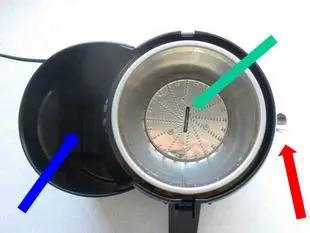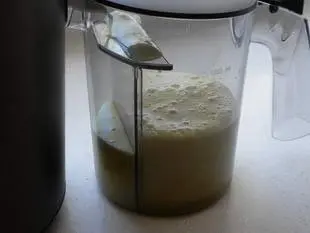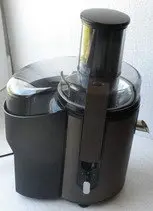To find out more...
How to choose a centrifugal juicer

 The principle is very simple: the chosen fruit is fed into the top of the machine through a pipe called a "chimney".
The principle is very simple: the chosen fruit is fed into the top of the machine through a pipe called a "chimney".
 The fruit is washed, but not peeled as this is not necessary. They are pulverized by a grater which rotates at very high speed (green arrow), the pulp obtained is thrown against a very fine grid where the juice is extracted by centrifugal force (hence the name), the "dry" pulp is ejected at the rear into a collection tray (blue arrow), and the precious juice is collected in a pitcher (red arrow).
The fruit is washed, but not peeled as this is not necessary. They are pulverized by a grater which rotates at very high speed (green arrow), the pulp obtained is thrown against a very fine grid where the juice is extracted by centrifugal force (hence the name), the "dry" pulp is ejected at the rear into a collection tray (blue arrow), and the precious juice is collected in a pitcher (red arrow).
 Note that the resulting juice is very, very frothy, and you'll need to wait a few minutes for it to settle before the froth rises to the top and the (clear) juice settles to the bottom.
Note that the resulting juice is very, very frothy, and you'll need to wait a few minutes for it to settle before the froth rises to the top and the (clear) juice settles to the bottom.
Selection criteria
There are all sorts of centrifuge models and brands to choose from, and having hesitated a great deal before taking the plunge, I'd like to give you the points I consider important, or not, in making your choice.What's important
- Power and speed: these determine the machine's capacity and efficiency. To be efficient, it needs to turn very fast (8,000 rpm minimum), and be powerful (500 watts minimum) to avoid jamming during operation.
- The recovery pitcher: This essential element receives the juice that flows from the centrifuge, and is designed so that when you pour, the foam remains in the pitcher and only the juice flows out.
- The pulp tank or pulp selector: A tank at the back of the centrifuge that receives the pulp from whatever you're juicing, it allows you to juice large quantities of fruit before having to clean the machine.
- The size of the chimney: The larger the chimney, the better, as it allows you to process whole fruits (apples, for example) without cutting them.
Not essential
- Centrifuge parts are dishwasher-safe, but cleaning by hand is easier and more effective.
- The centrifuge's spout can be raised to avoid dripping onto the work surface, which is just handy.
- Several rotation speeds, although we always use the maximum speed.
- Citrus juicer function, but of little interest.
To sum up
- 500 Watts, 800 rpm minimum
- Recovery pitcher
- Pulp bin
My choice
Based on these criteria, I opted for a Philips HR 1858, which I bought for around €150 in 2010. I'm very happy with it, although it broke down after 1 month and was sent to the after-sales service for 3 weeks... But since then, it's been a real pleasure to use: Grany apple juice, for example, made in 1 minute, is simply divine!
But since then, it's been a real pleasure to use: Grany apple juice, for example, made in 1 minute, is simply divine!
Butter vs. grease
We often read in a recipe where a pastry is put into a mould that, just before pouring, the mould should be buttered or greased. But what's the difference between these 2 terms?December 1st 20251,3595
Getting out of the fridge early
Very often when you're cooking, you need to take food or preparations out of the fridge, to use them in the recipe in progress. There's nothing tricky about this: you just take them out of the fridge and use them, usually immediately, in the recipe. But is this really a good method?November 24th 20251,2625
Who's making the croissants?
When you look at a bakery from the outside, you naturally think that in the bakery, the bakers make the bread, and in the laboratory, the pastry chefs make the cakes. It's very often like that, with each of these professions having quite different ways of working, but sometimes there's also one...November 23th 20251,146
Oven height
When we put a dish or cake in the oven, we naturally tend to put it on the middle shelf, and that's what we usually do. But in some cases, this position and height can be a little tricky, so let's find out why.October 8th 20253,1795
The importance of sieving
In recipes that use a fine powder (flour, powdered sugar, etc.), you'll often see the advice to sift before using it. To sift is to pass the powder in question through a sieve (a very fine strainer) before incorporating it into your recipe. It's often advice, but is it really useful?September 3rd 20257,8343
Different kinds of pastry and dough
When cooking in general, and particularly in baking, we can make and use many different kinds of pastry and dough. All built on the same "base": flour - a powder to which we add fat, liquid or both to produce the dough which is then cooked. .November 6th 2012111 K 14.0
Double cooking of vegetables
When you cook vegetables, it's not easy to capture and preserve the flavours. It is easy to undercook, but you can make up for it, or overcook, and then it is unfortunately a bit cooked (in the sense of "ruined"). But above all, how to get the maximum of the taste of the vegetable in the pan, then...July 12th 201925 K4.1
Thermal inertia or "out of the fire"
When you're cooking, you need a lot of heat to cook, and most of the time it's on the fire, literally if you're on gas, more indirectly if you're not. An expression that comes up quite often is "Off the heat", but what does it really mean?December 12th 202011 K4.6
Burgers and cheeses
A quick look at burgers(article from 2 weeks ago), and in particular the cheese in burgers, many of you have asked me about this, and how to get cheese to melt in your burgers.April 24th 20219,6864.8
In praise of the whetstone
Have you ever seen a butcher or a chef sharpen his knife before using it? Usually he uses a special tool, a long thin cylinder made of very hard metal. And in a smooth and elegant gesture, he very quickly passes the edge of the knife against the rifle, which makes a very characteristic noise,...June 5th 202112 K4.8









